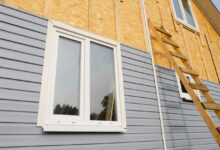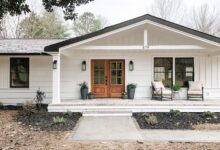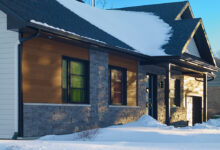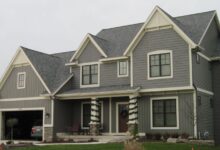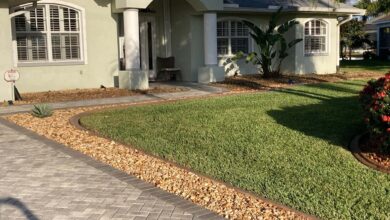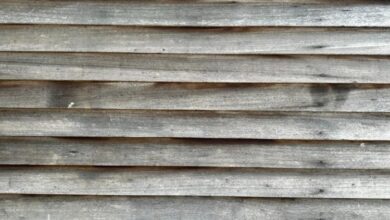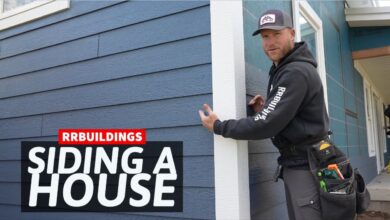Siding Replacement: Upgrade Your Exterior Now
Siding Replacement: Signs It’s Time to Upgrade Your Exterior – Your home’s exterior siding is its first line of defense against the elements. Over time, exposure to sun, wind, rain, and even insects can take a toll, leading to damage that impacts both curb appeal and the structural integrity of your home. This guide will help you identify the signs that it’s time for a siding replacement, explore various materials and their lifespans, and navigate the process of upgrading your home’s exterior for lasting beauty and protection.
We’ll cover everything from recognizing the subtle signs of deterioration—like warping, cracking, or fading—to understanding the costs involved and choosing the right contractor. We’ll also delve into the importance of considering the overall condition of your home’s exterior, ensuring a holistic approach to maintenance and longevity. By the end, you’ll be equipped to make informed decisions about whether to repair or replace your siding and how to manage the entire project effectively.
Identifying Signs of Siding Deterioration
Your home’s siding plays a crucial role in protecting it from the elements. Over time, exposure to sun, wind, rain, and insects can take its toll, leading to deterioration. Regular inspection is key to identifying problems early and preventing costly repairs down the line. Ignoring these signs can lead to more extensive and expensive damage.
Common Signs of Siding Damage
Recognizing the various signs of siding deterioration is crucial for determining the necessary course of action. Early detection can help prevent minor issues from escalating into major problems requiring complete replacement. The following table outlines common signs, their severity, and recommended actions.
| Sign of Damage | Description | Severity Level | Recommended Action |
|---|---|---|---|
| Warping | Siding panels become bent or twisted out of shape, often due to moisture absorption or extreme temperature changes. | Medium to High | Repair or replacement of affected panels; investigate and address moisture issues. |
| Cracking | Visible cracks or splits in the siding, often indicating age, impact damage, or underlying structural problems. | Low to High | Repair or replacement depending on the extent and location of the cracks. |
| Fading | Loss of color and vibrancy due to prolonged sun exposure and weathering. | Low | Cleaning or repainting may suffice; consider more durable siding for future replacements. |
| Insect Infestation | Evidence of wood-boring insects, such as holes, sawdust, or insect activity. This is particularly relevant for wood siding. | Medium to High | Pest control treatment; may require extensive repairs or replacement depending on the extent of infestation. |
Moisture Damage and Its Consequences
Moisture intrusion is a significant contributor to siding deterioration. Water can seep into siding through cracks, gaps around windows and doors, damaged flashing, or improperly installed siding. Prolonged exposure to moisture leads to rot, mold growth, and structural damage, significantly reducing the lifespan of the siding and potentially impacting the home’s structural integrity. Examples of moisture intrusion points include: gaps around window frames, deteriorated caulking, damaged flashing, and improperly sealed seams between siding panels.
Minor Repairs vs. Complete Replacement
The decision to repair or replace siding depends on the extent and type of damage. Minor repairs, such as patching small cracks or replacing individual damaged panels, are often cost-effective solutions for localized issues. However, widespread damage, such as significant warping, extensive rot, or insect infestation affecting numerous panels, necessitates complete siding replacement.
Comparative Illustration of Repairable and Irreparable Siding Damage
Imagine two sections of siding. The first shows a single, small crack in one panel, easily patched with caulk and paint. This represents repairable damage. The second section shows multiple warped and rotting panels with visible insect damage and significant discoloration across a large area. This depicts irreparable damage requiring complete replacement. The visual difference lies in the scale and severity of the damage; localized damage is repairable, while widespread damage necessitates replacement for comprehensive protection and aesthetic appeal.
Evaluating Siding Materials and Their Lifespans
Choosing the right siding for your home is a significant investment, impacting both its aesthetic appeal and long-term durability. Understanding the properties of different siding materials and their expected lifespans is crucial for making an informed decision that aligns with your budget and maintenance preferences. This section will compare various siding options, focusing on their durability, maintenance needs, cost-effectiveness, and lifespan.
A homeowner’s choice of siding material should consider factors beyond initial cost. Durability, maintenance requirements, and longevity all play significant roles in the overall value proposition. The following comparison highlights key differences among popular siding options.
Siding Material Comparison
The following bulleted list compares the durability, maintenance, and cost-effectiveness of common siding materials. Remember that actual performance can vary based on factors such as climate and installation quality.
- Vinyl Siding: Offers good durability and low maintenance, requiring only occasional cleaning. It’s relatively inexpensive but may fade or become brittle over time in extreme climates. Its lifespan is generally shorter than other options.
- Wood Siding: Provides a classic aesthetic and can be customized with various stains and paints. However, it requires significant maintenance, including regular painting or staining, to prevent rot and insect damage. It’s more expensive than vinyl but offers a longer lifespan with proper care.
- Fiber Cement Siding: Combines the durability of cement with the versatility of wood. It’s highly resistant to fire, rot, and insects, requiring minimal maintenance. While more expensive than vinyl, it boasts a very long lifespan and superior durability.
- Aluminum Siding: Offers excellent durability and low maintenance, resisting rust and insect damage. It’s lightweight and relatively easy to install. While less expensive than fiber cement, it can dent easily and may not offer the same aesthetic appeal as wood or fiber cement.
Factors Influencing Siding Lifespan
Several factors significantly influence how long your siding will last. Understanding these factors can help you make informed decisions about material selection and maintenance practices.
| Siding Material | Average Lifespan (Years) | Influencing Factors |
|---|---|---|
| Vinyl | 20-30 | UV exposure, extreme temperatures, improper installation |
| Wood | 30-50+ | Climate, regular maintenance (painting/staining), insect infestation |
| Fiber Cement | 50-80+ | Climate, installation quality, potential for cracking if not properly installed |
| Aluminum | 40-50 | Denting, exposure to harsh weather conditions |
Innovative and Sustainable Siding Materials
The siding industry is constantly evolving, with new materials offering improved sustainability and performance. Here are a few examples.
- Recycled Plastic Siding: Made from recycled plastic materials, this option offers good durability and low maintenance while reducing landfill waste. Its lifespan is comparable to vinyl siding. For example, companies are increasingly using recycled plastic lumber to create durable and aesthetically pleasing siding options.
- Bamboo Siding: A rapidly renewable resource, bamboo siding offers a sustainable alternative to traditional wood. It requires regular maintenance to prevent moisture damage, and its lifespan is comparable to certain types of wood siding depending on treatment and climate. Proper treatment is crucial to extend its lifespan in humid climates.
Assessing the Overall Home Exterior Condition
Replacing your siding is a significant investment, and while focusing on the siding itself is crucial, a holistic approach to exterior home maintenance ensures the longevity of your upgrade and maximizes your return on investment. Ignoring other exterior elements can lead to unforeseen problems and negate the benefits of new siding. A comprehensive assessment of your home’s exterior is vital before undertaking any siding replacement project.
Considering the interconnectedness of various exterior components is essential for effective and long-lasting home maintenance. Roofing, windows, and gutters all interact with the siding, and neglecting any one area can compromise the others, even after significant investment in new siding. A systematic approach to assessing the overall condition of your home’s exterior helps identify potential issues and prevents future, more costly repairs.
Interconnectedness of Exterior Elements
The various components of a home’s exterior work together to protect the structure from the elements. For example, damaged roofing can allow water to penetrate, causing rot and damage to underlying wood, which can affect the performance and longevity of new siding. Similarly, failing gutters can lead to water damage around the foundation and siding, even causing premature failure of the new siding installation. Compromised window seals can also lead to moisture intrusion, affecting both the siding and the interior walls. Addressing these interconnected issues simultaneously ensures a more comprehensive and lasting solution.
Impact of Neglecting Other Exterior Components
Deferred maintenance on other exterior components can significantly compromise the longevity of new siding. For instance, if the underlying wood framing is rotted due to water damage from leaking gutters or a failing roof, the new siding will not effectively protect the structure. The rot can continue to spread, potentially leading to warping, buckling, or premature failure of the new siding. In another example, if your windows are drafty and allow significant moisture penetration, this moisture can compromise the siding, leading to mold growth and deterioration. This would not only negate the aesthetic improvements from the new siding but also create health and structural issues.
Home Exterior Condition Checklist
Before starting a siding replacement project, a thorough evaluation of your home’s exterior is crucial. This checklist helps identify areas needing attention alongside the siding replacement.
This checklist will help ensure a complete assessment of your home’s exterior before siding replacement:
- Roofing: Inspect for missing or damaged shingles, signs of leaks, or excessive wear. Consider the age of the roof; a roof nearing the end of its lifespan should be replaced before or concurrently with siding replacement.
- Windows: Check for cracked or broken panes, damaged seals, and drafts. Worn-out caulking around window frames can lead to moisture intrusion, impacting the siding.
- Gutters and Downspouts: Examine for clogs, leaks, sagging, or damage. Properly functioning gutters are vital for diverting water away from the foundation and siding.
- Foundation: Look for cracks, settling, or signs of water damage. Foundation issues can affect the overall stability of the house and impact the siding.
- Fascia and Soffit: Inspect for rot, damage, or insect infestation. These components are crucial for protecting the underside of the roof and the exterior walls.
- Exterior Walls (beyond siding): Check for any signs of water damage, rot, or insect infestation on the underlying structure. This includes checking for cracks or damage in brick or stucco.
Budgeting and Planning for Siding Replacement
Replacing your siding is a significant investment, but careful planning can ensure a smooth and cost-effective process. Understanding the various cost components and selecting a reliable contractor are crucial steps in achieving a successful project. This section will guide you through budgeting, contractor selection, and permit acquisition.
Cost Components of Siding Replacement
Several factors contribute to the overall cost of siding replacement. Accurate estimation requires considering material costs, labor fees, permits, and waste disposal. Failing to account for all these elements can lead to unexpected expenses and project delays.
| Cost Component | Estimated Cost Range | Notes |
|---|---|---|
| Materials (Siding, Trim, Flashing) | $3,000 – $15,000+ | Cost varies greatly depending on siding type (vinyl, fiber cement, wood, etc.), quality, and quantity needed. |
| Labor | $5,000 – $15,000+ | Labor costs depend on the project’s size, complexity, and the contractor’s hourly rate or per-square-foot pricing. |
| Permits and Inspections | $200 – $1,000+ | Permit fees vary significantly by location and project scope. Inspections are typically required at various stages. |
| Waste Disposal | $200 – $500+ | Costs depend on the amount of waste generated and local disposal regulations. |
| Contingency (Unexpected Costs) | 10-15% of total estimated cost | This accounts for unforeseen issues like rotted sheathing or unexpected repairs. |
A sample budget for a 1500 sq ft house with vinyl siding might look like this:
| Cost Component | Estimated Cost |
|---|---|
| Materials | $6,000 |
| Labor | $7,500 |
| Permits | $500 |
| Waste Disposal | $300 |
| Contingency (10%) | $1,350 |
| Total Estimated Cost | $15,650 |
Remember that this is just an example, and your actual costs may vary significantly. It is crucial to obtain multiple detailed quotes from reputable contractors.
Selecting and Working with a Siding Contractor
Choosing the right contractor is vital for a successful siding replacement. Thorough research and careful communication are essential.
- Obtain at least three written estimates, comparing materials, labor costs, and warranties.
- Verify contractor licensing, insurance, and references. Check online reviews and ratings.
- Ensure a clear and detailed contract outlining project scope, payment schedule, timelines, and warranty information.
- Maintain open communication throughout the project, addressing any concerns promptly.
- Regularly monitor the project’s progress and ensure adherence to the agreed-upon timeline and quality standards.
Obtaining Necessary Permits and Compliance with Building Codes
Building permits ensure your project complies with local codes and regulations, protecting your investment and ensuring safety.
Before starting any work, contact your local building department to determine the specific permits required for siding replacement. Provide them with detailed plans and specifications. Expect inspections at various stages of the project, including before installation, during installation, and upon completion. Failure to obtain the necessary permits can result in fines or even project halt. Always work with a contractor who is familiar with local building codes and permit processes.
Understanding the Siding Replacement Process
Replacing your siding is a significant home improvement project requiring careful planning and execution. A well-managed process ensures a beautiful, durable, and long-lasting result. This section details the typical steps involved, highlighting the importance of preparation and various installation techniques.
Project Stages: A Step-by-Step Guide
The siding replacement process typically unfolds in several key stages. A thorough understanding of each step helps homeowners manage expectations and ensures a smooth project flow.
- Initial Consultation and Assessment: This involves a detailed discussion with a contractor to assess your needs, review existing siding conditions, and discuss material options. Measurements are taken, and a comprehensive quote is provided, including material costs, labor, and permits. Visual: Imagine a contractor using a measuring tape to carefully document the dimensions of your house, taking notes on the existing siding type and condition.
- Permitting and Material Procurement: Necessary building permits are obtained. Siding materials, including trims, flashing, and fasteners, are ordered and delivered to the site. Visual: Picture a delivery truck unloading pallets of new siding materials onto your driveway, ready for installation. This image emphasizes the scale of the project.
- Site Preparation and Protection: This crucial step involves protecting landscaping, windows, doors, and other home features from damage. This might include covering plants with tarps, protecting windows with plastic sheeting, and masking off areas not being worked on. Visual: Imagine your landscaping meticulously covered with heavy-duty tarps and carefully secured, while windows and doors are shielded with protective coverings. This image emphasizes the meticulous preparation involved.
- Removal of Existing Siding: Careful removal of the old siding is essential to avoid damaging the underlying sheathing or causing further issues. This often involves using specialized tools and techniques to minimize debris. Visual: Envision a team carefully removing sections of old siding, taking care not to damage the underlying wall structure. Debris is collected and disposed of responsibly. This illustrates the careful and precise nature of this stage.
- Sheathing Inspection and Repair: The underlying sheathing is thoroughly inspected for damage, rot, or insect infestation. Any necessary repairs are made before new siding is installed. Visual: Imagine a close-up view of a contractor inspecting the wall sheathing, looking for signs of damage. This shows the thoroughness of the inspection process and the importance of repair work.
- Siding Installation: This involves installing the new siding according to manufacturer specifications and best practices. Different installation methods exist, depending on the siding type. Visual: Imagine a team of workers efficiently installing new siding, working methodically from the bottom up. This shows the installation of the new siding, highlighting the neat and precise manner in which it is being installed.
- Finishing and Cleanup: Final touches are added, such as installing trim, flashing, and caulking. The work area is thoroughly cleaned, and all debris is removed. Visual: Picture a completed project, with neatly installed siding, clean gutters, and a completely cleared work area. This demonstrates the final, polished look of the completed project.
Importance of Proper Preparation and Site Protection
Protecting your property during the siding replacement process is paramount. Failing to do so can lead to costly repairs to landscaping, windows, or other features. Methods used include covering plants and other delicate elements with protective sheeting, carefully masking off areas that are not being worked on, and using drop cloths to prevent debris from damaging surfaces. Proper preparation minimizes disruption and safeguards your investment.
Siding Installation Techniques
Different siding materials require specific installation methods. For example, vinyl siding is typically installed using a lap siding technique, while fiber cement siding may require nailing or fastening methods specific to the product. The chosen installation method directly impacts the final appearance and longevity of the siding. Improper installation can lead to gaps, water damage, or other issues, highlighting the importance of hiring experienced professionals.
Wrap-Up
Upgrading your home’s exterior siding is a significant investment that enhances both its aesthetic appeal and its structural integrity. By carefully evaluating the condition of your current siding, understanding the available options, and planning the project meticulously, you can transform your home’s exterior into a beautiful and durable haven. Remember to consider not only the siding itself but also the interconnectedness of other exterior elements for a truly comprehensive and lasting upgrade. With careful planning and the right contractor, your siding replacement project will not only enhance your home’s value but also provide peace of mind for years to come.

